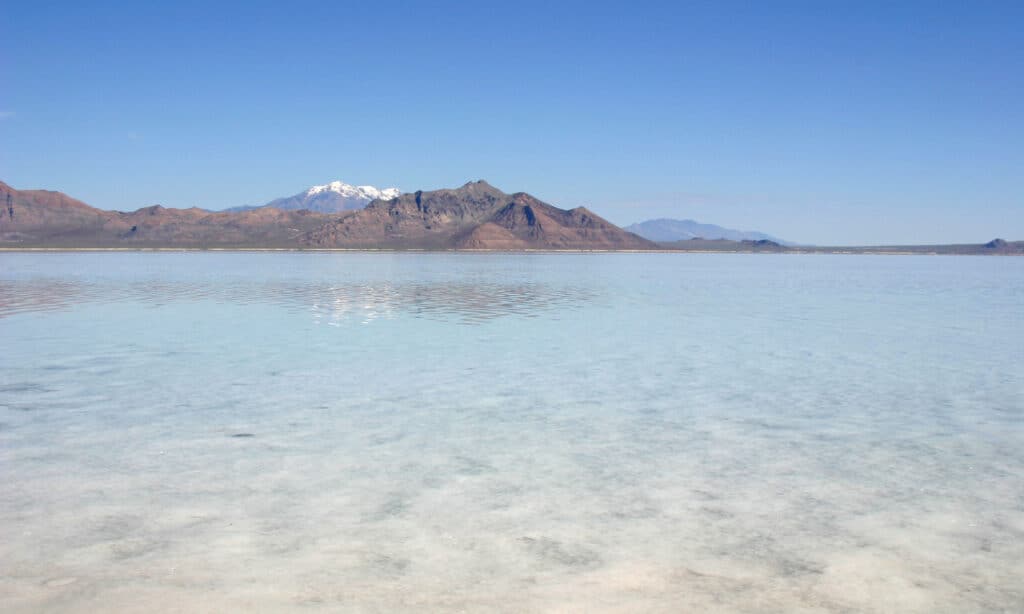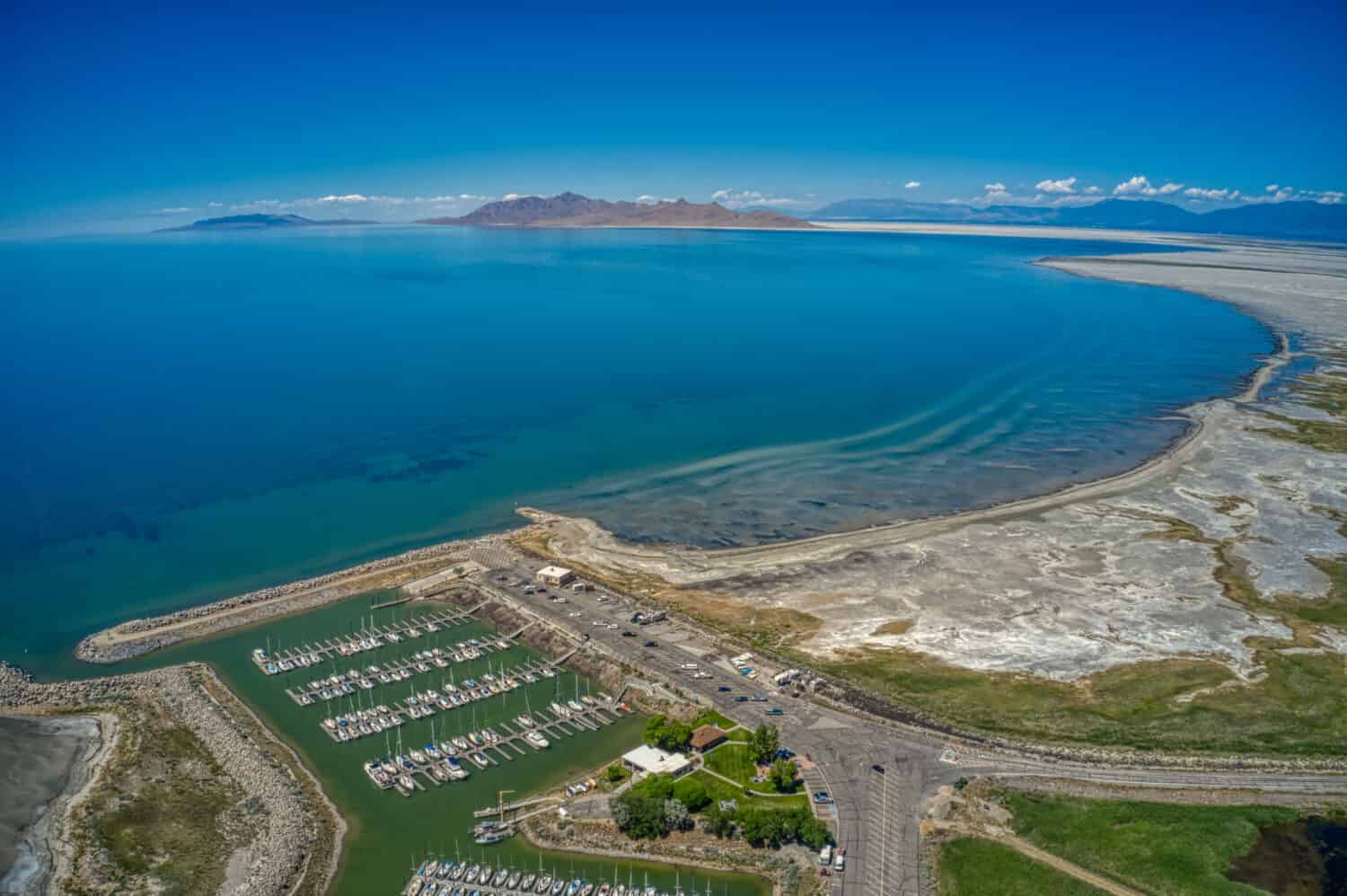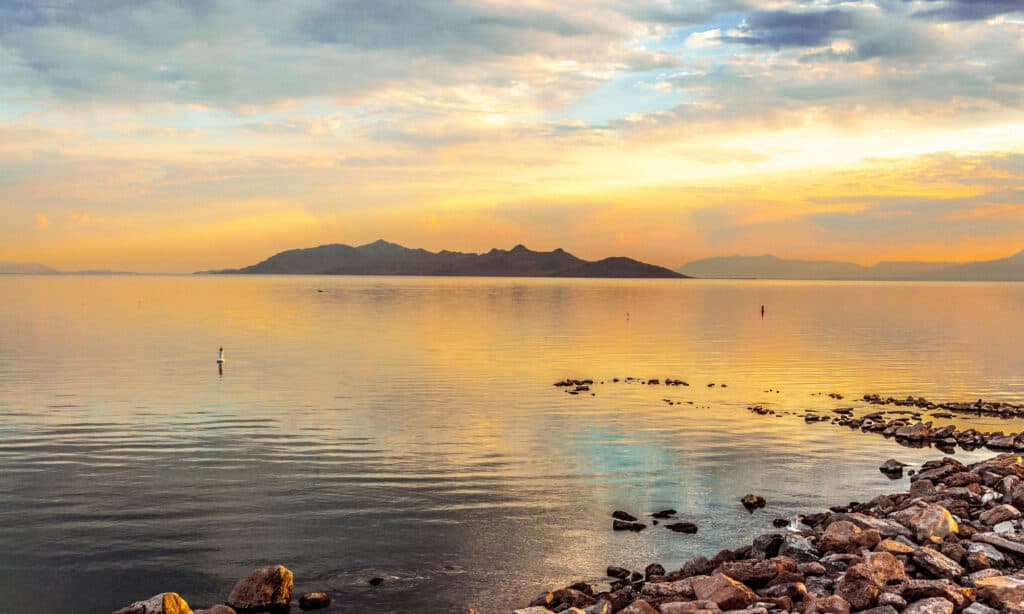About the Great Salt Lake
The Great Salt Lake is the largest saltwater lake in the western hemisphere and the largest salt lake west of the Mississippi River by surface area. This incredible natural feature, which inspired the name for Salt Lake City, Utah (originally named Great Salt Lake City, before the “great” was removed from the name in 1868), has a vibrant history and an important role in the entire surrounding ecosystem. This article covers some of the key aspects of the Great Salt Lake and how you can visit and enjoy this famous geologic feature of the western United States. Let’s dive in now!

How Wide Is the Great Salt Lake?
The Great Salt Lake is about 74.5 miles long and about 28 miles wide. It has an average depth of only 14 feet and a maximum depth of 33 feet. This shallow depth allows much of the lake’s surface to be exposed to the area, making the lake subject to great fluctuations in temperature over the course of the seasons. The conditions and water levels of the lake change regularly over the course of the year, varying greatly from season to season and how year to year.

The calm waters of the
Great Salt Lake
.
©iStock.com/beccarie
Where is the Great Salt Lake?
The Great Salt Lake is located in the northern part of Utah in the United States. Today, the existing lake is a remnant of Lake Bonneville, an ancient lake still steeped in legend. In history, early European explorers believed the lake must be connected to the Pacific Ocean. However, the lake is landlocked – despite its high salt content, it is not connected to an ocean. In northern Utah, the lake is near two state parks in the Salt Lake Valley: Great Salt Lake State Park and Antelope Island State Park. Both of these offer the opportunity to explore and enjoy the lake.
The foothills of the Wasatch Range east are north, east, and south of the Great Salt Lake Basin. The Great Salt Lake Desert is to the west.
As a terminal saltwater lake, the Great Salt Lake does not have any outflows. The lake is fed by the Bear, Weber, and Jordan Rivers but does not have an outlet. This means that rainwater and meltwater rushing down into the lake bring many minerals. These minerals remain in the lake even as the water itself evaporates. For that reason, the lake water is extremely briny – sometimes even compared to the Dead Sea. Like the Dead Sea, the high salt content of the Great Salt Lake gives swimmers an experience of buoyancy and extreme saltiness.
The lake is north and west of Salt Lake City. When visiting, you can route either to Antelope Island, which can be reached by car via a causeway, or go straight to the State Park on the south side of the lake.
How Long it Takes to Swim Across the Great Salt Lake

A beach at the Great Salt Lake in Utah.
©Jacob Boomsma/Shutterstock.com
Since the lake is 28 miles across, a swimmer who swims at the average speed of 2 miles per hour could complete a swim across the lake in approximately 14 hours. However, swimming in the lake is not a very popular choice except among a few. The lake is saltier than the ocean. This means that getting the salty water in your eyes or in a cut or scrape can be very painful! The lake also gives off a strong, decaying odor known as “lake stink,” due to the large amount of decaying organic matter in the bottom of the lake. This also provides an environment conducive to flies, mosquitoes, and other bugs.
But if that does not deter you, you are in luck! Each year, the Great Salt Lake Open Swim event attracts visitors from around the United States. They come to experience the largest terminal saltwater lake, floating or swimming in the salty lake water. Join in the swim from the mainland to Antelope Island, or simply watch the annual spectacle take place.
There are a few surrounding beaches on the lake’s sandy shores. These include Bridger Bay Beach on Antelope Island and the beach of Great Salt Lake State Park. On Antelope Island, you will find white sandy beaches where many visitors swim and sunbathe. Freshwater showers nearby allow you to rinse the salty water off of your skin after you are done swimming.
How the Great Salt Lake Compares to Other Lakes
As a terminal lake, with no outflows and only inflows, the Great Salt Lake may be compared with Mono Lake in California and Pyramid Lake in Nevada. Both of these are located in the Great Basin region of the Western United States. However, these lakes are situated in deeper basins. As a result, their water levels do not fluctuate as much as the water in the Great Salt Lake. Most terminal lakes have a high mineral content and, like the Great Salt Lake, are very salty. Among these, the Great Salt Lake is the largest in the western hemisphere and one with some of the highest salinity.
This lake also has a significantly larger surface-area-to-volume ratio than other lakes nearby. As a result, much of the lake’s water evaporates every day, impacting the lake’s depth and surrounding weather. The Great Salt Lake’s surface area has varied from about 2,400 square miles at its highest levels to about 950 square miles at its very lowest levels.
In northern Utah, the lake is surrounded by immense stretches of sand, salt flats, and marshland. The nearby land provides opportunities for camping year-round, with park campsites and RV sites. The state parks also have beautiful lake vistas, boat slips, and motorboat access. Visit the state park website to learn more about how you can boat or camp in the area.
Things to Do at the Lake

A view of the Great Salt Lake from Antelope Island State Park.
©Bella Bender/Shutterstock.com
The Great Salt Lake gives both residents and visitors plenty of opportunities for water sports and outdoor recreation, from sailing to kayaking and birdwatching and hiking. Go on a long bike ride, hike the park, or swim or float in the lake’s salty water at Antelope Island State Park. If the salty water is not for you, hike or bike the island’s nature trails, take in awe-inspiring views, or watch for local bird species and other native wildlife.
You likely will not want to try fishing, however. Though there are many fish living in the nearby freshwater marshes and inlets, fish do not survive the lake’s salty water. Instead, you may find brine shrimp in the lake and brine flies on the lake’s shorelines.
Wildlife Near the Lake

A beautiful sunset over the Great Salt Lake in Utah.
©iStock.com/rinriver0423
Though the lake lacks a large fishing industry or a significant amount of aquatic life, the Great Salt Lake is still an essential part of the Utah ecosystem. With large swaths of wetlands along the lake’s shore, insect species that are drawn to the water providing a vital source of food, and numerous bird species stopping in the area on their migration, this area is a prime birdwatching destination. Over 10 million birds, from 338 species, come to the habitats surrounding the Great Salt Lake. These include grebes, phalaropes, avocets, pelicans, egrets, black-crowned night herons, sandhill cranes, and gulls.
In addition to that, Utah is home to many unique plant and animal species to discover and appreciate. The area surrounding the Great Salt Lake has large land mammals, including bison, deer, antelope, and their predators – coyotes, bobcats, and even the extremely rare wolverine.
You might also see mule deer, burrowing owls, jackrabbits, bighorn sheep, and many other mammals in the area near the lake.
The photo featured at the top of this post is © iStock.com/Zhi Gong
Thank you for reading! Have some feedback for us? Contact the AZ Animals editorial team.







